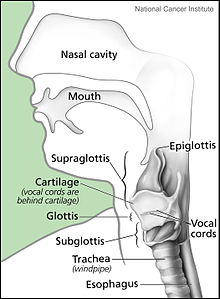User:Lmatias2/sandbox
Subglottis
[edit]
The subglottis or subglottic region is the lower portion of the larynx, extending from just beneath the vocal cords down to the top of the trachea.[1]
The subglottis gets its name for being located underneath the glottis.
Structure
[edit]The subglottis is located at the top of the trachea. It is described as being rhomboid in shape. The exact borders of the subglottis are contested. Most agree that the inferior border of the subglottic region is the inferior margin of the cricoid cartilage, while the lateral border is believed to be at the elastic cone and the perichondrium of the cricoid cartilage. The subglottic region in women tends to be smaller vertically than in men.[2]
Microanatomy
[edit]The subglottis consists of a lateral wall, an anterior wall, and a dorsal wall. All three walls include a layer of respiratory epithelium containing mucous-secreting goblet cells. The lateral wall has a layer of connective tissue with a tight capillary plexus that also includes granulocytes and lymphocytes. There is an elastic cone that extends from the inferior arcuate line to the lower margin of the vocal muscle. The soft connective tissue surrounding the anterior wall contains elastic fibres and the highest density of seromucous glands in the area. The dorsal wall is surrounded by tight connective tissue with a fibroelastic laryngeal membrane, which serves as a second elastic fibre system in addition to the elastic cone.[3]
Development
[edit]The subglottis increases in size during the first two years of life. The infant subglottis differs from the adult subglottis in its position and cartilage composition.[4]
Function
[edit]The subglottis is believed to play an important role in the temperature regulation of the breath. The subglottal region is surrounded by a dense capillary plexus supplied by the superior thyroidal artery. The presence of large veins with numerous anastomoses leads to strong blood flow that would serve to warm up the breath. Vasodilation in response to inflammation may also allow for a fast release of defense cells to the area, suggesting that the subglottis may be involved in the immune response to the area.[3]
Clinical significance
[edit]Subglottic stenosis
[edit]Subglottic stenosis is the narrowing of the subglottis. It can compromise the airway and cause voice dysfunction. It is most commonly caused by injury following orotracheal intubation or a high tracheostomy. Other causes include gastroesophageal reflux disease and subglottic tumours. In some cases, surgery may be required.[5]
Laryngeal cancer
[edit]The microanatomy of the subglottic region has been implicated in facilitating the spread of laryngeal cancer. While the elastic cone is generally viewed as an efficient barrier to tumour growth, piercing vessels can create weak spots that may allow tumours to spread more effectively. The superior border of the subglottic region is also covered by different epithelia, including stratified squamous epithelium, where cancer may arise.[6]
Granulomatosis with polyangiitis
[edit]Granulomatosis with polyangiitis is a rare disorder that causes inflammation of the blood vessels in the respiratory tract and kidneys. The larynx is affected in 13% of cases, particularly the subglottis which is affected in 96.3% of those cases. This may result in scarring or stenosis of the subglottis, often requiring a tracheotomy.[3]
 | This is a user sandbox of Lmatias2. You can use it for testing or practicing edits. This is not the sandbox where you should draft your assigned article for a dashboard.wikiedu.org course. To find the right sandbox for your assignment, visit your Dashboard course page and follow the Sandbox Draft link for your assigned article in the My Articles section. |
- ^ "Definition of Subglottis". MedicineNet. Retrieved 2021-03-17.
- ^ Carter, Donald R.; Meyers, Arlen D. (1978-03-01). "The Anatomy of the Subglottic Larynx". Otolaryngology. 86 (2): ORL–279. doi:10.1177/019459987808600217. ISSN 0161-6439.
- ^ a b c Kutta, Hannes; Steven, Philipp; Paulsen, Friedrich (2006). "Anatomical definition of the subglottic region". Cells, Tissues, Organs. 184 (3–4): 205–214. doi:10.1159/000099628. ISSN 1422-6421. PMID 17409747.
- ^ Eckel, H. E.; Sprinzl, G. M.; Sittel, C.; Koebke, J.; Damm, M.; Stennert, E. (2000-07). "[Anatomy of the glottis and subglottis in the pediatric larynx]". HNO. 48 (7): 501–507. doi:10.1007/s001060050606. ISSN 0017-6192. PMID 10955227.
{{cite journal}}: Check date values in:|date=(help) - ^ Thurnher, Dietmar; Moukarbel, Roger V.; Novak, Christine B.; Gullane, Patrick J. (2007-11-01). "The Glottis and Subglottis: An Otolaryngologist's Perspective". Thoracic Surgery Clinics. 17 (4): 549–560. doi:10.1016/j.thorsurg.2006.11.002. ISSN 1547-4127. PMID 18271168.
- ^ Reidenbach, M. M. (1998). "Subglottic region: normal topography and possible clinical implications". Clinical Anatomy (New York, N.Y.). 11 (1): 9–21. doi:10.1002/(SICI)1098-2353(1998)11:13.0.CO;2-R. ISSN 0897-3806. PMID 9445092.
